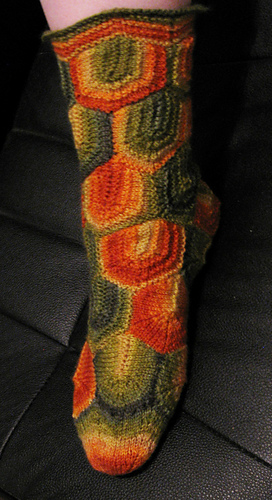patterns >  Kirsten Hall Designs
Kirsten Hall Designs
> Ziprelaxagon










Ziprelaxagon
Buy 3 get 1 free. Place 4 patterns in your cart and the least expensive one will be free!
Zipper + entrelac + hexagon = Ziprelaxagon!
These socks make the most of painted yarns.
This is an 11-page pattern with charts, diagram, full written instructions in three sizes (with an option to work sizes in between), many photos of the construction, and links to helpful videos.
What’s fun about this pattern
Painted yarns show their colors. Say goodbye to weaving in ends (almost) because the units and cuff are connected in one continuous strand, entrelac-style. Only the toe is a separate piece. There’s no grafting or seaming. The Zipper is a fun way to close up each colorful unit. Fit can be customized.
What’s challenging about this pattern
This pattern is for advanced and adventurous knitters. Knitting in multiple directions and dimensions will reward you with beautiful socks. The units become familiar with practice, but the shaping of the heel will keep you thinking.
What you should know before you begin
It will be helpful to have worked entrelac or any form of modular knitting. These socks are a cousin to both. You should be comfortable with working in the round on small needles, either circular or double-pointed. And, as my fortune cookie said this year, “A handful of patience is worth more than a bushel of brains.”
Some notes on construction
The hexagon units are worked first, starting from the toe and continuously through the heel and up to the cuff. Then the knitter has the option to either finish the cuff and go back to the afterthought toe, or start the toe and finish the cuff last. It all depends on your yarn-conservation needs. Instructions are given for shorter or narrower feet, for eliminating a tier of hexagons, or for adding a tier to extend the calf. The sole and heel can be worked smooth instead of textured, if desired.

- First published: March 2011
- Page created: March 3, 2011
- Last updated: November 26, 2022 …
- visits in the last 24 hours
- visitors right now




